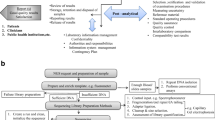Abstract
To strengthen clinical laboratories’ capabilities, the Reference Health Laboratory (RHL) of the Ministry of Health decided to compile a national professional laboratory standard to be followed by all medical laboratories in the country. Providing a national laboratory standard, as approved criteria for competency assessment, is also essential for establishment of a national accreditation system for medical laboratories. ISO 15189 addresses different processes and activities in a medical laboratory, but considering the local situation and limitations in the country it was not feasible to implement all the requirements of ISO 15189 at once in laboratories in different sectors and in different provinces of the country. For this reason, the RHL decided to define and publish the national standard, as minimum quality requirements that could be mandatory for all clinical laboratories throughout the country. After conducting a countrywide situation analysis, a national standard was composed by RHL expert committees and officially announced in September 2007. The main reference of this standard was ISO 15189:2007, although some important technical details were added to it from other credible references, such as WHO documents and CLSI guidelines. In this study, the Iranian national standard is compared to ISO 15189:2007 in terms of format and content in order to show how an international standard was localized for compiling a national standard.
Similar content being viewed by others
References
World Health Organization (2007), International Health Regulations(2005) Areas of work for implementation. WHO/CDS/EPR/IHR:5–6
Safadel N, Dahim P et al (2013) Challenges of implementing Iranian national laboratory standards. Iran J Public Health 42(Supp 1):125–128
Dahim P, Amini R et al (2009) Implementation of quality management system in Iranian medical laboratories. Iran J Public Health 38(Supp 1):150–152
WHO (2011) WHO guide for the stepwise laboratory improvement process towards accreditation in the African Region, WHO Regional office of Africa
International Standard (2007)Medical laboratories—particular requirements for quality and competence ISO15189
International Standard (2005) General requirements for the competence of testing and calibration laboratories ISO/IEC17025
Wattanasri N, Manoroma W, Viriyayudhagorn S (2010) Laboratory accreditation in Thailand: a systemic approach. Am J Clin Pathol 134:534–540
de Kieviet W, Frank E, Stekel H (2009) Essentials of clinical laboratory management in developing regions. IFCC Series
Gyani GJ, Krishnamurthy B (2014) The National Accreditation Board for Hospital and Health Care Providers accreditation programme in India. World Hosp Health Serv 50(1):9–12
Handoo A, Sood SK (2012) Clinical laboratory accreditation in India. Clin Lab Med 32(2):281–292. doi:10.1016/j.cll.2012.04.009
Uras F (2009) Quality regulations and accreditation standards for clinical chemistry in Turkey. Clin Biochem 42(4–5):263–265. doi:10.1016/j.clinbiochem.2008.09.008
Kusum M, Silva P (2005) Quality standards in health laboratories implementation in Thailand. WHO regional office for South-East Asia
Pongpirul K, Sriratanaban J et al (2006) Comparison of health care professionals and surveyors opinions on problems and obstacles in implementing quality management system in Thailand. Int J Qual Health Care 18(5):346–351
Anjarani S, Safadel N et al (2013) Establishment of national laboratory standards in public and private hospital laboratories. Iran J Public Health 42(1):96–101
WHO (1997) Safety in health care laboratories, WHO/LAB/97
WHO (2004) Laboratory biosafety manual, World Health Organization. Third edition. Geneva
CLSI document(1998) Laboratory design; approved guideline GP18-A. CLSI second edition. USA
CLSI document (1998) Clinical laboratory safety; approved guideline GP17-A2. CLSI second edition. USA
CLSI document (1998) Protection of laboratory workers from occupationally acquired infection; approved guideline M29-A3. CLSI Third Edition. USA
CLSI document(1998) Selecting and evaluating a referral laboratory; approved guideline GP09-A CLSI Second Edition. USA
Author information
Authors and Affiliations
Corresponding author
Additional information
Papers published in this section do not necessarily reflect the opinion of the Editors, the Editorial Board and the Publisher.
A critical and constructive debate in the Discussion Forum or a Letter to the Editor is strongly encouraged.
Rights and permissions
About this article
Cite this article
Safadel, N., Anjarani, S., Farzami, M.R. et al. Establishing an Iranian medical laboratory standard based on ISO 15189. Accred Qual Assur 19, 473–476 (2014). https://doi.org/10.1007/s00769-014-1090-3
Received:
Accepted:
Published:
Issue Date:
DOI: https://doi.org/10.1007/s00769-014-1090-3




